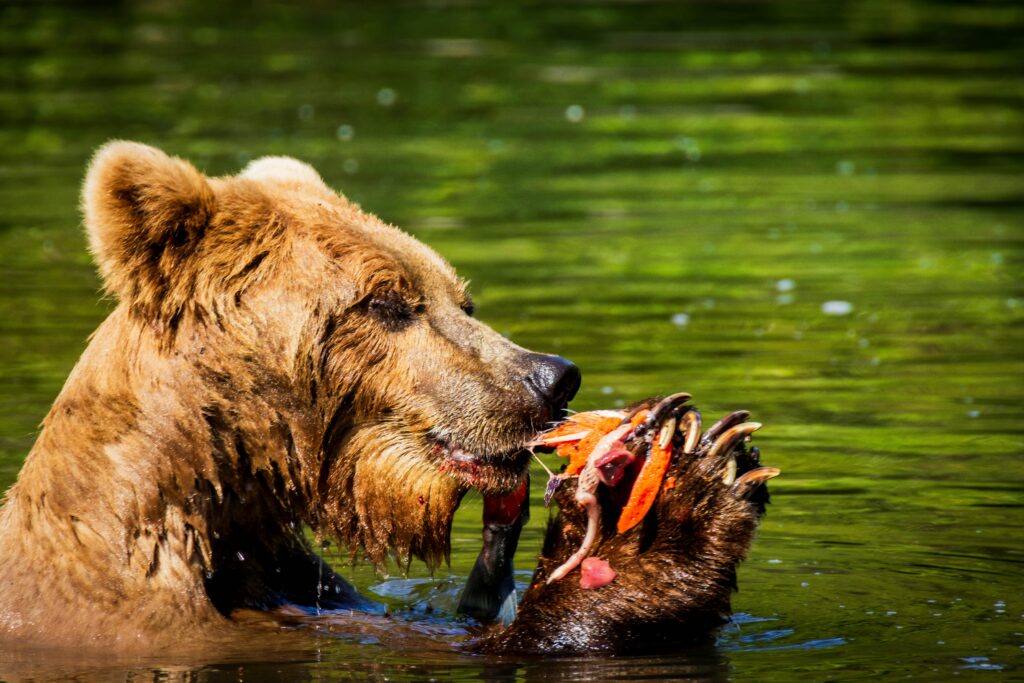Canada

Bear Fishing
In Canada, nature isn’t just something you go out to find — it’s something that defines where you are. It’s in the breath of cold air that smells like spruce. In the hush of a lake holding morning mist. In the long silence that follows a wolf’s distant howl. This is a country shaped by wilderness, where wildlife still moves as it always has — quietly, freely, and on its own terms.
Canada doesn’t ask for your attention. It waits. With forests so vast you could walk for days without seeing another soul. With tundra where the horizon is broken only by caribou, or the flick of a snowy owl’s wings. With shorelines where bears turn over rocks for crabs and orcas slip through kelp forests without a sound. Here, the wild is not a spectacle. It’s a presence — one that surrounds you, even when you can’t see it.
Landscapes That Still Belong to the Wild
Wildlife That Belongs to the Landscape
In Canada, animals don’t come to you. You step into their world. A bear crossing a logging road leaves only silence behind. A moose lifting its head from a river looks through you, not at you. These aren’t performances — they’re lives, happening whether you watch or not. That’s what makes it meaningful when they let you near.
Species That Tell the Story of the North
Seasons That Shift the Story
Spring melts snow and stirs the wetlands. Summer brings long light and bear cubs. Autumn glows with migration and the moose rut. Winter strips the land to bone and shadow — and suddenly, you see more by seeing less. In Canada, the seasons aren’t background. They are the wildlife’s rhythm — and yours too, if you stay long enough.
Final Thoughts
To know Canada’s wildlife, you have to go beyond the road. Beyond the visitor center. Sometimes, beyond your own expectations. It’s a place that rewards the quiet observer, the early riser, the one willing to wait in the cold. Because when the wild appears here, it doesn’t just impress you. It changes you. And that, maybe more than anything, is what the North has always done best.
Canada doesn’t ask for your attention. It waits. With forests so vast you could walk for days without seeing another soul. With tundra where the horizon is broken only by caribou, or the flick of a snowy owl’s wings. With shorelines where bears turn over rocks for crabs and orcas slip through kelp forests without a sound. Here, the wild is not a spectacle. It’s a presence — one that surrounds you, even when you can’t see it.
Landscapes That Still Belong to the Wild
- Boreal Forest: Stretching from coast to coast, this immense, silent forest is home to moose, lynx, beavers, and countless birds. In spring, it comes alive with migration. In winter, tracks in snow tell stories no one saw.
- Canadian Rockies: Not just scenery — but home to grizzlies, mountain goats, wolves, and elusive wolverines. Every pass, ridge, and valley holds a trail older than any human map.
- Arctic Tundra: Beyond the tree line, the land flattens, but life continues — polar bears, musk oxen, arctic foxes, and migratory birds that fly thousands of miles to nest where the sun never sets.
- Pacific Coast: Rainforests soaked in fog and salmon. Spirit bears wandering the undergrowth. Humpback whales rising through silver seas. A meeting place of land, ocean, and ancient memory.
- Prairies & Wetlands: Wide open skies, buffalo grass, and wetlands bursting with life — cranes, waterfowl, foxes, badgers, and the quiet endurance of species adapted to vastness.
Wildlife That Belongs to the Landscape
In Canada, animals don’t come to you. You step into their world. A bear crossing a logging road leaves only silence behind. A moose lifting its head from a river looks through you, not at you. These aren’t performances — they’re lives, happening whether you watch or not. That’s what makes it meaningful when they let you near.
Species That Tell the Story of the North
- Grizzly Bear: Not just a symbol, but a keystone — shaping salmon runs, forests, and fear in equal parts. Common in western Canada and parts of the Yukon.
- Moose: Towering and solitary — often spotted in wetland edges or browsing in birch groves at dusk.
- Wolverine: Fierce, wide-ranging, and almost mythical in its elusiveness. Found in remote forests and mountains — a rare gift to see.
- Polar Bear: On the Hudson Bay ice and in the far north, they roam the edges of survival — enormous, quiet, and powerful.
- Snowy Owl: A winter visitor to southern fields, but truly at home in the tundra — ghostlike, watching.
Seasons That Shift the Story
Spring melts snow and stirs the wetlands. Summer brings long light and bear cubs. Autumn glows with migration and the moose rut. Winter strips the land to bone and shadow — and suddenly, you see more by seeing less. In Canada, the seasons aren’t background. They are the wildlife’s rhythm — and yours too, if you stay long enough.
Final Thoughts
To know Canada’s wildlife, you have to go beyond the road. Beyond the visitor center. Sometimes, beyond your own expectations. It’s a place that rewards the quiet observer, the early riser, the one willing to wait in the cold. Because when the wild appears here, it doesn’t just impress you. It changes you. And that, maybe more than anything, is what the North has always done best.
